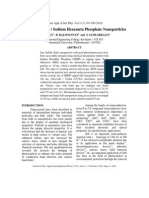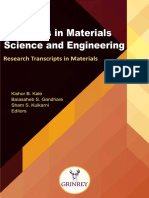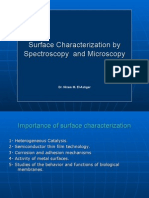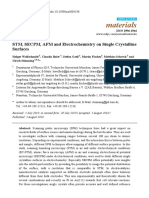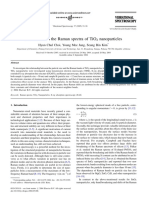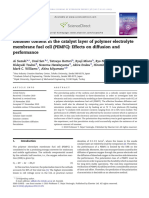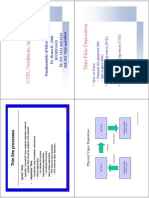Interaction of Low-Energy Ions 10 Ev) With Polymethylmethacrylate During Plasma Treatment
Interaction of Low-Energy Ions 10 Ev) With Polymethylmethacrylate During Plasma Treatment
Uploaded by
Fernando BonattoCopyright:
Available Formats
Interaction of Low-Energy Ions 10 Ev) With Polymethylmethacrylate During Plasma Treatment
Interaction of Low-Energy Ions 10 Ev) With Polymethylmethacrylate During Plasma Treatment
Uploaded by
Fernando BonattoOriginal Title
Copyright
Available Formats
Share this document
Did you find this document useful?
Is this content inappropriate?
Copyright:
Available Formats
Interaction of Low-Energy Ions 10 Ev) With Polymethylmethacrylate During Plasma Treatment
Interaction of Low-Energy Ions 10 Ev) With Polymethylmethacrylate During Plasma Treatment
Uploaded by
Fernando BonattoCopyright:
Available Formats
surface science
ELSEVIER
Applied Surface Science 89 (1995) 83-91
Interaction of low-energy ions ( < 10 eV) with polymethylmethacrylate during plasma treatment
P. Griining *, O.M. Kittel, M. Collaud-Coen,
Received 12 September 1994; accepted for publication
G. Dietler, L. Schlapbach
1.5 January 1995
Physics Department, University of Fribourg, Ptrolles, CH-1700 Fribourg, Switzerland
Abstract Using in-situ X-ray photoelectron spectroscopy (XPS) we investigated the chemical modification of the polymethylmethacrylate (PMMA) surfaces after plasma and low-energy ion beam treatment. A comparison between plasma and ion
beam treatment has shown, that for noble gases both treatments produce absolutely the same modifications of the chemical composition on the PMMA surface. In reactive gases (O,, N2) molecular ions were found to decompose polar bonds at the
polymer surface, but they do not contribute to the incorporation of reactive gas atoms. Reactive atomic ions and radicals are responsible for this incorporation. We found that in the case of PMMA less than three ions are needed to decompose the ester group (O-C=O) completely. Therefore, we conclude that the decomposition of the ester group by ions is a chemical
and not a physical effect due to the kinetic energy of the ions.
1. Introduction Having a polymer with properties that differ at its surface and in the bulk is nowadays a very important research field in polymer chemistry, e.g. for packaging industry or for capacitor fabrication. In the last two decades, plasma-polymer interactions have been actively studied because of their unique ability to modify polymer surfaces without affecting their bulk properties [l]. It was shown that substantial changes in the chemical functionality, surface texture, wettability, and bondability of polymer surfaces can be achieved by plasma treatment or ion bombardment of these materials [2].
Corresponding author. E-mail: pierangelo.groening@unifr.ch; Fax: +41 37299747.
l
Many theories have been proposed for the increased adhesion of films on plasma-treated polymers. Introduction of new reactive chemical species, the elimination of weak boundary layers, actual chemical changes such as oxidation and increased surface roughness due to pitting may play a role in improving adhesion. We believe that the incorporation of new reactive chemical species into the polymer surface, to form polar functional groups, is of prime importance. The adhesion strength of metals to polymers has been related to the reactivity and strength of bonding of the first monolayer with reactive surface functional groups, especially oxygen-containing groups [3-71. Gerenser observed that the adhesion strength of Ag films on polyethylene (PE) and polyethyleneterephthalate (PET) was increased by O,-plasma pretreatment of the polymer surfaces, whereas Ar-plasma pretreatment has shown
0169-4332/95/$09.50 0 1995 Elsevier Science B.V. All rights reserved S.SDI 0169-4332(95)00013-5
84
P. Griining et al. /Applied Surface Science 89 (1995) 83-91
minimal effect on the adhesion strength [8]. Even though the effects of polar groups such as C-O or C=O bonds on the adhesion strength of metal films are well investigated, very little is known regarding how these functional groups are incorporated into the polymer surface by plasma treatment. In a plasma, a polymer surface is exposed to a broad spectrum of ions, electrons, neutrals, radicals, and electromagnetic radiation. Due to their specific properties each of these particles may have their own influence on the modification of the polymer surface. Considering that the penetration depth of low energy ions in a solid is extremely small, ions seem to be very important for the modifications in the first few nanometers of the polymer surface during plasma treatment. Our aim was the comparison of a plasma treatment with a pure and well defined ion beam treatment regarding the induced surface modifications. Since we are interested in the surface modification in the first few nanometers an in-situ technique of the polymer treatment and the surface analysis is necessary in order to eliminate disturbing contaminations from the transfer in air. A plasma chamber and a mass- and energy-selected ion gun, vacuum connected to a surface analysis spectrometer, allows in-situ experiments to be performed with well defined conditions. X-ray photoelectron spectroscopy (XPS) was used to anaiyse the polymer surface, a diagnostic tool well-adapted to study plasma ion modification of polymers, since it has a high surface sensitivity. In the present contribution we report about the chemistry of low-energy ions (5-100 eV> with the polymer surface. We compare the effects of plasma and ion gun treatments on the surface composition of polymethylmethacrylate (PMMA).
2. Experimental details The plasma treatment was performed in a high vacuum chamber (base pressure 4 X 10m8 mbar) connected to the surface spectrometer, which enabled an in-situ surface analysis to be performed without atmospheric contact. The excitation of the plasma is done by electron cyclotron resonance (ECR) with permanent rare-earth magnets and microwaves of
2.45 GHz frequency at pressures ranging from 4 x 10m4 to 10e2 mbar. The details of this ECR plasma chamber have been published elsewhere [9]. The ECR plasmas are generally characterized by fairly high charged-particle densities and ionization degrees. The physics of ECR microwave discharges has been reviewed by Asmussen [lo]. The plasma treatments were carried out with a microwave power of 200 W. The operating gas pressure was kept at 10m3 mbar for all experiments which corresponds to a gas flow of 1.5 seem. The ion treatment experiments were made with a self-constructed mass- and energy-selected ion source. Ions up to 2048 amu in mass and with an energy of 5-500 eV can be selected from a Penning discharge chamber by a quadrupole mass filter. The design of the ion source prevents the exposure of the sample to UV/VUV radiation. The details of this ion source have been described elsewhere [ll]. For UV experiment we used a xenon excimer lamp with a wavelength of 172 nm and an intensity of 10 mW cm-* at a distance of 1.5 cm. The distance from the sample to the lamp was N 5 cm. The excimer lamp was built by U. Kogelschatz from Asea Brown Boveri (Baden, Switzerland). Details of the excimer lamp have been described elsewhere [12,13]. The ion flux on the sample for the plasma and the ion beam experiments were measured by a Faraday cup [9,14]. XPS was performed in a VG ESCALAB 5 spectrometer operating at a base pressure lower than lo- mbar. The analyses were carried out with non-monochromatized Mg Ka (hv = 1253.6 eV) radiation. The instrument was calibrated to the 4f,,, peak of gold at E, = 84.0 eV and the copper 2p3,2 peak at E, = 932.7 eV. Survey spectra and high-resolution spectra were taken with 50 eV and with 20 eV pass energy, respectively, in the constant analyser energy (CAE) mode. The mean free path for inelastiz scattering of 1.0 keV electrons in PMMA is 27 + [15], which results in a probing depth of about 80 A for the Mg Ka radiation. The X-ray source was operated at 200 W (10 kV, 20 mA). Due to sample degradation effects the measurement time was kept as short as possible [16]. Element concentrations were evaluated from peak areas after Shirley background subtraction using theoretical cross sections 1171. Charging of the PMMA samples, due to the photoemission, was corrected by setting the binding
P. Griining et al. /Applied Surface Science 89 (1995) 83-91 Table 1 Binding energy and relative peak area of the fitted expected C 1s and 0 1s peaks, respectively, of PMMA Peak No. Cls 1 2 3 4 1 2 E, (eV) 285.0 285.9 286.8 289.0 532.1 533.8 Fitted peak area (%) 43 21 19 17 50 50
85
and the
Expected peak area (o/o) 40 20 20 20 50 50
01s
280
285 Bindlng Energy [eVl
200
The PMMA samples were commercial non-crosslinked PMMA foils of 100 pm thickness from RShm GmbH (Germany). The samples were used without any preparation.
3. Results and discussion 3.1. Plasma and ion beam treatment with argon We shall first consider the effects of Ar-plasma treatment on the elemental surface composition of
Binding Energy [ev]
Fig. 1. C 1s and 0 1s XPS spectra of the untreated PMMA surface with fitted peaks associated to the repeating structural units of the
polymer.
I
r t 0
energy of the main peak (hydrocarbon component) of the C 1s spectrum at 285.0 eV [18]. In Fig. 1 we present as a reference, together with a representation of the chemical structure of the monomer, the deconvoluted C 1s and 0 1s core-level photoemission spectrum of PMMA. The peak labels in the spectra correspond to the carbon and oxygen atoms having different environments in the monomer. The fits are based on reference measurements of Beamson and Briggs [18], and were performed by keeping the binding energies and the widths of the peaks constant to the literature values, while varying the intensities. At 20 eV pass energy the peak widths of our spectra are 1.5 times larger than the literature values [18] measured with monochromatized X-rays. The binding energy and the relative peak area of the fitted peaks are given in Table 1.
294
292
290
280
286
284
282
280
Blnding Energy [rV] Fig. 2. Cls detail XPS spectra of the untreated and Ar-plasmatreated PMMA surface with two different ion doses, which correspond to 2 and 10 s treatment time, respectively.
86
P. Griining et al. /Applied Surface Science 89 (1995) 83-91
PMMA as a function of ion dose. Fig. 2 shows XPS detail spectra of the C 1s core level of the untreated PMMA surface and after Ar-plasma treatment with two different ion doses. The ion dose was varied by changing the treatment time from 2 to 10 s. The spectra reveal that the amount of C-O and C=O functionalities from the ester group (O-C=O> decreases with increasing ion dose, indicated by the reduced intensity of the corresponding peaks, at 286.8 and 289 eV binding energy, respectively, labelled as 3 and 4 in the reference spectrum (Fig. 1). After Ar-plasma treatment with an ion dose of 1.0 X 10 the oxygen content on the PMMA surface cm- decreases from 26 to 7 at%, which corresponds to an oxygen reduction of 73%. It is still an open question, if really only ions are responsible for the decomposition of the ester groups. To give an answer to this question we compared plasma treatment experiments with low-energy ion beam experiments. For the ion beam experiments the kinetic ion energy was kept at 10 eV. This energy corresponds to the plasma potential [19], and consequentially to the kinetic energy of the ions in our ECR plasma [9]. In Fig. 3 we plot the oxygen-tocarbon ratio [O/C] of the Ar-plasma and Arf ion treated PMMA surface as a function of ion dose. The plot demonstrates an excellent correlation between the plasma and the ion beam treatment. This observation leads to the conclusion that the chemical modification of the polymer surface is due to low-energy ions from the Ar plasma.
294
292
290
206
266
284
262
Blnding Energy [eV] Fig. 4. Deconvoluted Cls XPS spectrum PMMA (ion dose: 0.2 X 10 cm-). of Ar-plasma-treated
o-oo-o~s
0 50 100 150
Ion dose [om-2]
Fig. 3. Oxygen-to-carbon (O/C) ratio of the AI plasma or Ar+ ion beam treated PMMA surface as a function of the ion dose.
To evaluate the sputtering effect of the ions due to the kinetic energy we performed ion beam experiments with different ion energies. In the kinetic energy range between 5 and 100 eV no changes in the modifications of the surface composition were observed, which indicates that the decomposition of the ester group is a chemical and not a physical effect. After the Ar-plasma treatment the C 1s spectra (Fig. 2) show not only reduced intensities of the peaks corresponding to the oxygen functionalities. Shifts in the binding energy of these peaks are also detectable, visible by the different peak shape in the binding energy range between 287 and 292 eV of the spectrum obtained after plasma treatment with 0.2 X 10 cm-* ion dose. Apparently the Ar-plasma treatment reduces the number of ester groups on the PMMA surface by partial degradation, and leads to the formation of intermediate new oxygen functionalities. The deconvoluted C 1s spectrum shown in Fig. 4 reveals, that the plasma decomposes the oxygen functionalities (GO, C-O) of the ester in order of their polarity, higher polarity first, indicated by the stronger decrease of the corresponding peaks, labelled as 3 and 4 in the reference spectrum (Fig. 1). One would expect such a behaviour simply on the
P. Grhing
et al. /Applied
Surface Science 89 (1995) 83-91
87
basis of the ion-dipole interaction, which is stronger and more probable for the high-polarity bonds [20]. Once the ion is attracted in the proximity of a high-polarity bond, it can recombine with one of the electrons of the bond. Our observations suggest a two-step process with two different pathways for the degradation of the PMMA surface due to ions, presented schematically in Fig. 5. In the first step the ion reacts with the partially negatively charged carbony1 oxygen and forms an unstable intermediate state which has two possibilities to recombine. One by an electron transfer from the neighbouring C-C bond with cleavage and removal of the whole sidechain from the polymer, or with a lower probability, trapping hydrogen atom and forming a hydrocarbonate group. This hydrocarbonate group as a new chemical functionality at the PMMA surface induces the above-mentioned chemical shift in the C 1s spectrum (Fig. 2) obtained after treatment with a low (0.2 X lOi cm-2) ion dose. For high ion doses the hydrocarbonate groups will be decomposed like the carbonyl group, so that finally all oxygen functionalities are removed from the PMMA surface. Other degradation mechanisms such as main-chain scission or dehydrogenation are not represented in the schema because from other investigations on plasma-treated polypropylene (PP) we know that for a significant dehydrogenation a much higher ion dose than used for our experiments is needed [21]. For high ion dose the O/C ratio (Fig. 3) shows a lower limit of 0.07 which corresponds to an oxygen content of 5 at%. Principally, there are two possible phenomena explaining this behaviour. First, the depth of the modified PMMA surface is thinner than the XPS analysing depth (d, = 80 A>, or second by contamination from the plasma or oxygen diffusing from the bulk to the surface. To find out which of
294
292
290 280 286 204 Binding Energy [ev]
282
2:
Fig. 6. XPS spectra of Ar-plasma-treated PMMA surface measured under two different electron emission angles 6 (ion dose: 1.5 X 10 cm-).
nr*t stage
YFOMI
atage
w
+cn,-c*
% 5
+c&--
c*
-C-D.
+CH*--~~
I c-o I
G -c-o
P %
Fig. 5. Schematic illustration due to low-energy ions.
0 %
of the side-chain
P W
scission in PMMA
both phenomena is responsible, we analysed the treated PMMA surface under different electron emission angles 6 (analysing depth d: d = d, cos 8). In this manner it is possible to change the probing depth of the XPS analysis. Fig. 6 displays XPS spectra of Ar-plasma-treated PMMA analysed under two different electron emission angles (19= 0, 70). The absolute identical spectra indicate that the plasma treatment induces a modification at the PMMA surface which is at least hymogeneous over the XPS probing depth Cd,, = 80 A). Apparently the oxygen contamination from the plasma as well the limited probing depth of the XPS are not responsible for the observed residual oxygen, because in these cases the oxygen content should be varied by changing the electron emission angle. Diffusion stimulated by UV and VUV radiation during the plasma treatment or induced by X-rays during XPS surface analysis could occur. From the ion dose and the knowledge that the depth of the plasma-modified surface is at least 80 A we have calculated, that in the case of PMMA less than three ions are necessary to remove the whole side-chain from the polymer. This is an efficiency which is some orders of magnitude higher than the
P. Griining et al. /Applied Surface Science 89 (1995) 83-91
a)
550
b:
500
450 400 350 300 Blndlng Energy [ev]
250
200
Fig. 7. XPS survey spectra of different treated PMMA surface: (a) untreated, (b) N, plasma, (c) N: ion beam, (d) N+ ion beam.
sputtering yield of ions with kinetic energies of about 10 eV [221. The above-described depth uniformity of modified PMMA surface was only observed for high ion doses (> X lOI cm-). Treatments with low ion doses (< 5 X 1016 cm-*) show a gradient in the oxygen concentration at the PMMA surface. This dependence of the penetration depth on the ion dose can be explained again on the basis of the ion-dipole interaction. With increasing ion dose the number of polar bonds decreases and the probability of an ion-dipole interaction decreases, which results in longer mean free path and consequentially in a deeper penetration of the ion. 3.2. Plasma, ion beam and W treatment with reactive gases (0,) N,, CO,)
reactive gas plasma treatment which normally results in an incorporation of reactive atoms [23,24]. Fig. 7 shows XPS spectra of N, plasma, Ng and N+ ion beam (10 eV kinetic energy) modified PMMA surfaces. As expected, the spectra show that oxygen is etched away by the plasma and by the ion beam, indicated by the lower intensity of the 0 1s peak compared to the peak of the untreated surface. It is interesting to note that nearly no nitrogen is incorporated into the surface when bombarding the polymer with N: ions (Fig. 7~). The N: ions have not enough kinetic energy to be dissociated at the polymer surface. However, by using the very reactive N+ ions, nitrogen is incorporated in the polymer surface while oxygen is still removed (Fig. 7d). It is known from optical measurements that a microwave nitrogen plasma contains atomic nitrogen as ions and as radicals. These species are responsible for the incorporation of nitrogen and to a much lesser degree Nl ions. The N: ions as majority ions in a N, plasma decompose the ester on the PMMA surface by recombining with one of its electrons to form a volatile neutral molecule. Fig. 8 displays the C 1s core-level spectra of the untreated PMMA surface and spectra obtained upon
In the previous section we have demonstrated that Ar ions decompose the ester groups on the PMMA surface during noble-gas plasma treatment. This result suggests that molecular ions may also have a crucial role during reactive gas plasma treatment. In this section we shall consider the effect of the molecular ions on the PMMA surface modification during
284
280 288 288 284 Binding Energy [ev]
280
Fig. 8. C 1s XPS spectra of the untreated PMMA surface and after O,-plasma treatment for two different ion fluxes.
P. Griining et al. /Applied Surface Science 89 (1995) 83-91
89
10 s O,-plasma treatment with two different ion currents onto the sample. The ion flux was varied by changing the position of the sample in the plasma with constant treatment time. In this way the influence of the UV/VUV radiation is the same for both treatments and different surface modifications are correlated to the ion flux. A comparison of the spectra reveals a remarkable difference in the line shapes at higher binding energies between 286 and 291 eV. The C 1s electrons in this binding energy range are assumed to originate from oxygen functionalities (Fig. 1). The spectrum of the sample treated with low ion flux (I = 0.10 mA crnm2) shows in this energy range a higher intensity than the spectrum of the untreated sample, whereas the intensity is lower in the spectrum of the sample treated with high ion flux (I = 0.30 mA cm-*). We should emphasize that the decrease of the oxygen content on the PMMA surface in the O2 plasma is very surprising, because a reactive gas plasma treatment is expected to result in an incorporation of the reactive gas atoms into the polymer surface, as we have observed for PET [25]. The comparison between plasma and ion beam experiments with nitrogen has revealed that two competitive phenomena determine the chemical composition on the polymer surface during reactive gas plasma treatment. One is the decomposition of polar bonds due to impinging low-energy ions described above, which is a chemical etching process. On the other hand, reactive species can be incorporated. The results of an oxygen plasma with different ion currents to the substrate as presented in Fig. 8 is an illustration of this effect. While a high ion flux onto the substrate gives rise to an overall etching and decomposition effect, a low-ion-flux plasma leads to the incorporation of oxygen functionalities. As we know from the data given above, ions are responsible for the decomposition of chemical bonds. Let us now discuss what species lead to the incorporation at the surface. As pointed out in Fig. 7 atomic oxygen ions can break bonds and can be incorporated at the same time due to the high chemical reactivity. However, the fact that a lower ion flux gives a higher incorporation rate suggest that radicals could be at the origin rather than atomic ions, which anyway are produced at a very low rate in this kind of plasma source. The ion-to-radical ratio would then become a very impor-
294
292
290 266 266 284 Blnding Energy [eVj
262
I IO
Fig. 9. Cls XPS spectra of the PMMA surface untreated, after CO,-plasma treatment, and after UV irradiation (A = 172 nm) in a CO, atmosphere.
tant parameter, determining to which degree bonds are broken or species being incorporated. To further clarify that point several experiments were made where the effect of a CO, plasma on PMMA was compared to the 172 nm UV radiation from an excimer lamp in CO, atmosphere under the same pressure conditions (p = 10m3 mbar). Fig. 9 shows the result of these treatments. While the CO,plasma treatment reduces the oxygen functionalities on the PMMA surface an oxygen incorporation takes place for the UV irradiation as seen from the C 1s XPS spectra in the binding energy range between 286 and 291 eV. Similar to the 0: plasma, the high amount of ions in the CO, plasma dominate the modification on the PMMA surface by decomposing the oxygen functionalities. For the treatment with UV radiation the amount of ions is negligible and decomposition due to ions does not take place. The dissociation of the CO, molecule by UV irradiation at 172 nm wavelength with this low-power excimer lamp is not very probable. Only a two-photon adsorption process could produce such dissociation. However, such a process is only observed at very high power densities typically encountered in a fo-
90
P. Grijning et al. /Applied
Surface Science 89 (1995) 83-91
cused laser beam. Due to that the dissociation of the CO, molecule does note take place in the gas phase activation of the polymer surface is responsible for the adsorption of oxygen. Van der We1 and Lub [26] found for PMMA that by irradiation with UV light of wavelengths below 270 nm, side-chain scission with formation of volatile OCOCH,, CO, CO,, CH,O and CH, occurs. If this process would be important at 172 nm wavelength a decrease of the oxygen concentration should be visible in the XPS analysis. However, such a decrease could not be detected. At the wavelength of 172 nm main-chain scission stars to play a major damaging process in PMMA as pointed out by Ueno et al. [27]. Their results are in good agreement with our own measurements where we irradiated PMMA with 172 nm excimer radiation for l/h in high vacuum (p = 5 X lo- mbar) without observing any changes in the surface composition as measured by XPS. Esrom and Kogelschatz [28] measured the ablation rate of PMMA with a similar excimer lamp but with much higher intensity and proposed a photo-oxidative etching mechanism of the polymer surface. The possible modification steps during 172 nm UV irradiation are drawn in Fig. 10. The main chains are cleaved and CO, molecules are added to saturate the dangling bonds. The adsorption sites are left in a reactive state.
CH3 C%
The plasma is known to be a strong source of UV and VUV radiation [l] depending on the gas composition, the process pressure, and the power density. Furthermore, radicals can be easily formed in a plasma discharge and account for the incorporation of oxygen functionalities. Hollinder et al. 1291 have shown in a recent paper that VUV radiation from a plasma can be used to oxidize polymer surfaces. An oxygen plasma emits VUV and UV radiation of wavelength 112 5 A 5 135 nm and h 2 170 nm. They concluded that oxygen atoms play a relatively minor role in the plasma oxidation while the formation of radicals at the polymer surface by VUV and UV radiation seems to be the most important initiation step. The difference between the plasma and UV irradiation treatment on the chemical modification on the PMMA surface demonstrates the important role of the ion in the plasma. Changing the ion flux to the substrate by displacing the sample in the reactive gas plasma changes the equilibrium between incorporation and decomposition of polar bonds on the polymer surface, as we have demonstrated for the O2 plasma.
4. Conclusion The ability to perform plasma treatment and XPS surface analysis in situ allows the observation of the non-contaminated surface. The results can be directly related to the plasma processes responsible for the modifications of the polymer surface in the first few nanometers. The comparison between low pressure (p = 10d3 mbar) plasma and ion beam treatment with argon has shown that the modification in the chemical composition at the PMMA surface by plasma treatment can be qualitatively and quantitatively explained by the effect of the ions in the plasma. Ion recombination in the polymer leads to the decomposition of bonds in the order of their polarity. From experiments using nitrogen instead of argon we demonstrated that, independently of the plasma gas, the low-energy plasma ions decompose polar bonds at the polymer surface by an ion-electron recombination process. For reactive gas plasma treatment formation of polar bonds is crucial. For such treatments the amount of ions in the plasma
-cl+-c-ai*-c-c~-c-cN*-c-
I
I
ii
I
Fig. 10. Schematic illustration of the PMMA surface modification during UV irradiation with a wavelength of 172 nm in a CO, atmosphere.
P. Grhing
et al. /Applied Surface Science 89 (1995) 83-91
91
limits the maximal content of polar bonds possibly present at the surface. In the case of 0, and CO, plasma treatments we have demonstrated that the ion etching effect can be stronger than the incorporation effect, resulting in that the oxygen content at the PMMA surface was smaller after the plasma treatment than the intrinsic content. The ion beam experiments have shown that molecular Nl ions do not contribute to the incorporation of reactive gas atoms. Further we have seen that the sulbface layer modified by ions is relatively thick ( > 80 A) depending on the ion dose. We conclude that low-energy ions are able to vagabondize in the PMMA until they interact with a polar bond of the polymer with the consequence that in noble-gas plasma the thickness of the modified surface layer increases with increasing ion dose. As we demonstrated with this work the interaction of low-energy ions with polymers is an important issue in the modification of polymer surfaces by plasma treatment. In addition, this interaction may be important for the polymer/ metal interface formation during thin-film deposition. Deposition techniques with high particle energies such as sputtering where these particles can produce ions during the impact, should form an interface different from thermally evaporated films.
Acknowledgements
We would like to express our thanks to U. Kogelschatz from the Asea Brown Boveri Research Centre in Baden for lending us the xenon excimer lamp. The authors gratefully acknowledge financial support by the Swiss National Science Foundation, National Research Program 24, and Ciba-Geigy AG, Fribourg - Marly.
References
[l] E.M. Liston, Adhes. 30 (1989) 199. [2] S. Nowak and O.M. Kittel, Mater. (19931705. Sci. Forum 140-142
[3] J.M. Burkstrand, J. Appl. Phys. 52 (19811 4785. [4] L.J. Atanasoska, S.G. Anderson, H.M. Meyer III, 2. Lin and J.H. Weaver, J. Vat. Sci. Technol. A 5 (19871 3325. [5] P. BodG and J. Sundgren, J. Vat. Sci. Technol. A 6 (1988) 2396. [6] S. Akhter, X.-L. Zhou and J.M. White, Appl. Surf. Sci. 37 (1989) 201. [7] M. Bou, J.M. Martin and Th. Le Mogne, Appl. Surf. Sci. 47 (19911 149. [8] L.J. Gerenser, J. Vat. Sci. Technol. A 8 (1990) 3682. [9] S. Nowak, P. G&ring, O.M. Kittel, M. Collaud and G. Dietler, J. Vat. Sci. Technol. A 10 (1992) 3419. [lo] J. Asmussen, J. Vat. Sci. Technol. A 7 (1989) 883. [ll] O.M. Kiittel, P. Grdning and L. Schlapbach, J. Vat. Sci. Technol. A, submitted (19941. [12] U. Kogelschatz, Pure Appl. Chem. 62 (1990) 1667. [13] U. Kogelschatz, Appl. Surf. Sci. 54 (19921 410. [14] O.M. Kiittel, J.E. Klemberg-Sapieha, L. Martinu and M.R. Wertheimer, Thin Solid Films 193/194 (1990) 155. [15] R.F. Roberts, D.L. Allara, C.A. Pryde, D.N.E. Buchmann and N.D. Hobbins, Surf. Interf. Anal. 2 (1980) 5. [16] S. Nowak, H.P. Haerri, L. Schlapbach and J. Vogt, Surf. Interf. Anal. 16 (1990) 418. [17] J.J. Yeh and I. Landau, At. Data Nucl. Data Tables 32 (19851 7. [18] G. Beamson and D. Briggs, High Resolution XPS of Organic Polymers (Wiley, New York, 1992). [19] B. Chapman, Glow Discharge Processes (Wiley, New York, 1980). [20] J. Israelachvili, Intermolecular & Surface Forces. 2nd ed. (Academic Press, New York, 1991). [21] M. Collaud-Coen, P. Grijning, G. Dietler and L. Schlapbach, J. Appl. Phys., submitted (1994). ]22] H.H. Andersen and H.L. Bay, in: Sputtering Yield Measurements, Sputtering by Particle Bombardment I, Ed. R. Behrisch (Springer, Berlin, 1981). [23] S. Nowak, R. Mauron, G. Dietler and L. Schlapbach, in: Metallized Plastics, Vol. 2, Ed. K.L. Mittal (Plenum, New York, 1991) p. 233. [24] M. Collaud, S. Nowak, O.M. Kiittel, P. Groning and L. Schlapbach, Appl. Surf. Sci. 72 (19931 19. [25] P. Griining, M. Collaud, G. Dietler and L. Schlapbach, J. Appl. Phys. 76 (1994) 887. [26] H. van der We1 and J. Lub, Surf. Interf. Anal. 20 (1993) 373. [27] N. Ueno, T. Mitsuhata, K. Sugita and K. Tanaka, ACS Symp. Ser. 412 (1989) 424. [28] H. Esrom and U. Kogelschatz, Thin Solid Films 218 (1992) 231. [29] A. Hollander, J.E. Klemberg-Saphieha and M.R. Wertheimer, Macromolecules 27 (1994) 2893.
You might also like
- 1 Fabrication 20130218 PDFDocument108 pages1 Fabrication 20130218 PDFAjay kr PradhanNo ratings yet
- Parents, Jan 2011Document5 pagesParents, Jan 2011emediageNo ratings yet
- 6 - Influence of Oxygen and Nitrogen Plasma Treatment On PolyethyleneDocument3 pages6 - Influence of Oxygen and Nitrogen Plasma Treatment On Polyethylenekamrul.malNo ratings yet
- Surface Science Techniques For Analysis of Corrosion of The Ceramic SuperconductorsDocument17 pagesSurface Science Techniques For Analysis of Corrosion of The Ceramic SuperconductorsJuan Diego Palacio VelasquezNo ratings yet
- Adhesion of Copper To Poly (Tetrafluoroethylene-Co-Hexafluoropropylene) (FEP) Surfaces Modified by Vacuum UV Photo-Oxidation Downstream From Ar Microwave PlasmaDocument19 pagesAdhesion of Copper To Poly (Tetrafluoroethylene-Co-Hexafluoropropylene) (FEP) Surfaces Modified by Vacuum UV Photo-Oxidation Downstream From Ar Microwave PlasmaWilliams Marcel Caceres FerreiraNo ratings yet
- 7 - Surface Modification of Kapton Film by Plasma TreatmentsDocument7 pages7 - Surface Modification of Kapton Film by Plasma Treatmentskamrul.malNo ratings yet
- 1 s2.0 S0304388606001288 MainDocument5 pages1 s2.0 S0304388606001288 Mainabde lazizNo ratings yet
- Applied Surface Science: K. Navaneetha Pandiyaraj, V. Selvarajan, R.R. Deshmukh, Changyou GaoDocument7 pagesApplied Surface Science: K. Navaneetha Pandiyaraj, V. Selvarajan, R.R. Deshmukh, Changyou GaocallonidigoNo ratings yet
- Nanoscopic Carbon Electrodes CARBON RevisedDocument24 pagesNanoscopic Carbon Electrodes CARBON Revisedabdellahbe41No ratings yet
- Characterization of Anodic Spark-Converted Titanium Surfaces For Biomedical ApplicationsDocument5 pagesCharacterization of Anodic Spark-Converted Titanium Surfaces For Biomedical ApplicationstamilnaduNo ratings yet
- Preparation of Plasma-Polymerized SiOx-like Thin Films From A MixtureDocument6 pagesPreparation of Plasma-Polymerized SiOx-like Thin Films From A MixturekgvtgNo ratings yet
- Sdarticle 18Document4 pagesSdarticle 18Supatmono NAINo ratings yet
- Estc 2018 8546493Document5 pagesEstc 2018 8546493MSGNo ratings yet
- PlasmaDocument6 pagesPlasmaAlina Silvia CHIPERNo ratings yet
- Synthesis of Zns / Sodium Hexameta Phosphate Nanoparticles: R. Mohan, B. Rajamannan and S. SankarrajanDocument6 pagesSynthesis of Zns / Sodium Hexameta Phosphate Nanoparticles: R. Mohan, B. Rajamannan and S. SankarrajanphysicsjournalNo ratings yet
- Characterization of An Atmospheric Pressure Plasma JetDocument8 pagesCharacterization of An Atmospheric Pressure Plasma JetAjoy ChandaNo ratings yet
- Electromagnetic and Absorption Properties of Some Microwave AbsorbersDocument8 pagesElectromagnetic and Absorption Properties of Some Microwave AbsorbersIqbalKhanNo ratings yet
- 32-Article Text-154-1-10-20220605Document18 pages32-Article Text-154-1-10-20220605S A KaleNo ratings yet
- 1 s2.0 S0169433209001457 MainDocument8 pages1 s2.0 S0169433209001457 Mainranim najibNo ratings yet
- H. Kuroda Et Al - Observation of Advanced 18.9 NM Soft X-Ray Laser and Harmonics and Subharmonics Mixing in Femtosecond Radiation Pumped PlasmasDocument4 pagesH. Kuroda Et Al - Observation of Advanced 18.9 NM Soft X-Ray Laser and Harmonics and Subharmonics Mixing in Femtosecond Radiation Pumped PlasmasYuersNo ratings yet
- Liu 2000Document3 pagesLiu 2000milagros.alvitesNo ratings yet
- Kasian 2013Document8 pagesKasian 2013qnk7No ratings yet
- Experiments and Simulations For Optical Controlled Thermal Management On The Nanometer Length ScalaDocument6 pagesExperiments and Simulations For Optical Controlled Thermal Management On The Nanometer Length Scala김영규No ratings yet
- EXPERIMENT 8. Monolayer Characterization: Contact Angles, Reflection Infrared Spectroscopy, and EllipsometryDocument9 pagesEXPERIMENT 8. Monolayer Characterization: Contact Angles, Reflection Infrared Spectroscopy, and EllipsometryavniNo ratings yet
- L Oht2Document28 pagesL Oht2Atif NaumanNo ratings yet
- Experimentalphyslk III, Unwerszt T Diisseldorf. D-4000 Diisseldorf I, FRGDocument6 pagesExperimentalphyslk III, Unwerszt T Diisseldorf. D-4000 Diisseldorf I, FRGHeo Toàn TậpNo ratings yet
- Surface ChemistryDocument137 pagesSurface ChemistryMohammed86% (7)
- Methods To Study The Ionic Conductivity of Polymeric Electrolytes Using A.C. Impedance SpectrosDocument8 pagesMethods To Study The Ionic Conductivity of Polymeric Electrolytes Using A.C. Impedance Spectrosseung leeNo ratings yet
- STM, SECPM, AFM and Electrochemistry On Single Crystalline SurfacesDocument19 pagesSTM, SECPM, AFM and Electrochemistry On Single Crystalline SurfacesNguyễn Duy LongNo ratings yet
- 1999, Tokyo, JJAP - Electrical Properties of A Semiconducting Layer Formed On SrTiO3 Single Crystal by Excimer Laser IrradiationDocument6 pages1999, Tokyo, JJAP - Electrical Properties of A Semiconducting Layer Formed On SrTiO3 Single Crystal by Excimer Laser IrradiationHaribabu PalneediNo ratings yet
- Alan - Direct Creation of Micro Domains With Positive and Negative Surface Potential On Hydroxyapatite CoatingsDocument3 pagesAlan - Direct Creation of Micro Domains With Positive and Negative Surface Potential On Hydroxyapatite CoatingsanibalfisicoNo ratings yet
- Silicon Nanoparticles: Absorption, Emission, and The Nature of The Electronic BandgapDocument8 pagesSilicon Nanoparticles: Absorption, Emission, and The Nature of The Electronic BandgapbudhladaNo ratings yet
- Electrodeposition of Copper For Three-Dimensional MetamaterialDocument9 pagesElectrodeposition of Copper For Three-Dimensional MetamaterialYunzhe DuNo ratings yet
- Toroidally Resolved Structure of Divertor Heat Flux in RMP H-Mode Discharges On DIII-DDocument17 pagesToroidally Resolved Structure of Divertor Heat Flux in RMP H-Mode Discharges On DIII-DMarcin JakubowskiNo ratings yet
- Size Effects in The Raman Spectra of Tio Nanoparticles: Hyun Chul Choi, Young Mee Jung, Seung Bin KimDocument6 pagesSize Effects in The Raman Spectra of Tio Nanoparticles: Hyun Chul Choi, Young Mee Jung, Seung Bin Kimleoplasmo_201469720No ratings yet
- Properties of Multi-Walled: Thermal Carbon Nanotube-Reinforced Polypropylene CompositesDocument4 pagesProperties of Multi-Walled: Thermal Carbon Nanotube-Reinforced Polypropylene CompositesTai-Yuan HsuNo ratings yet
- Fe O - CNT Nanocomposite For Binary Gas Detection Monika Joshi, R.P Singh & Vidur RajDocument5 pagesFe O - CNT Nanocomposite For Binary Gas Detection Monika Joshi, R.P Singh & Vidur RajVidur Raj SinghNo ratings yet
- Enhancement of The Magnetic Properties of Ni-Cu-Zn Ferrites by The Non-Magnetic Al - Ions SubstitutionDocument5 pagesEnhancement of The Magnetic Properties of Ni-Cu-Zn Ferrites by The Non-Magnetic Al - Ions SubstitutionHuckkey HuNo ratings yet
- Modeling of Inhomogeneous Heating Behavior OLEN23Document29 pagesModeling of Inhomogeneous Heating Behavior OLEN23liviu9nanoNo ratings yet
- XPS and Water Contact Angle Measurements On Aged and Corona Treated PPDocument5 pagesXPS and Water Contact Angle Measurements On Aged and Corona Treated PPjulioNo ratings yet
- Enhanced Reactivity of Nanoenergetic Materials: A First-Principles Molecular Dynamics Study Based On Divide-And-Conquer Density Functional TheoryDocument3 pagesEnhanced Reactivity of Nanoenergetic Materials: A First-Principles Molecular Dynamics Study Based On Divide-And-Conquer Density Functional TheoryJuaxmawNo ratings yet
- 1-s2.0-S092702481000098X-main - For PresentationDocument5 pages1-s2.0-S092702481000098X-main - For PresentationFlorentin DumitruNo ratings yet
- Corona Discharge Treatment Versus Flame Treatment of PPDocument35 pagesCorona Discharge Treatment Versus Flame Treatment of PPmikehenrysamNo ratings yet
- Enhancement of Output Power Density in A Modified Polytetrafluoroethylene Surface Using A Sequential O2Ar Plasma Etching For Triboelectric Nanogenerator ApplicationsDocument8 pagesEnhancement of Output Power Density in A Modified Polytetrafluoroethylene Surface Using A Sequential O2Ar Plasma Etching For Triboelectric Nanogenerator ApplicationsAnthi LakhonchaiNo ratings yet
- Edwards - Mechanistic Studies of Corr Inhib Oleic ImidazolineDocument11 pagesEdwards - Mechanistic Studies of Corr Inhib Oleic ImidazolineJuan Manuel OlivoNo ratings yet
- International Refereed Journal of Engineering and Science (IRJES)Document8 pagesInternational Refereed Journal of Engineering and Science (IRJES)www.irjes.comNo ratings yet
- Progress in The Understanding of Tyramine Electropolymerisation MechanismDocument11 pagesProgress in The Understanding of Tyramine Electropolymerisation MechanismSarim DastgirNo ratings yet
- Ic 401215 XDocument20 pagesIc 401215 Xtedjini.mohammedhocineNo ratings yet
- Ionomer Content in The Catalyst Layer of Polymer Electrolyte Membrane Fuel Cell (PEMFC) Effects On Diffusion and PerformanceDocument9 pagesIonomer Content in The Catalyst Layer of Polymer Electrolyte Membrane Fuel Cell (PEMFC) Effects On Diffusion and PerformancermvanginkelNo ratings yet
- Relations Between Sample Preparation and SKPFM Volta Potential Maps On An EN AW-6005 Aluminium AlloyDocument14 pagesRelations Between Sample Preparation and SKPFM Volta Potential Maps On An EN AW-6005 Aluminium AlloyMARIA CAMILA VIERA BALLESTEROSNo ratings yet
- 2001 Surface Modification of Polyimide Using DBDDocument5 pages2001 Surface Modification of Polyimide Using DBDriazathar786No ratings yet
- L Menon Et Al (Appl Phy Lett 93 123117 2008) Ag AuDocument3 pagesL Menon Et Al (Appl Phy Lett 93 123117 2008) Ag AuTan KIm HAnNo ratings yet
- Microwave Properties of Spinal FerriteDocument5 pagesMicrowave Properties of Spinal FerriteInternational Journal of Application or Innovation in Engineering & ManagementNo ratings yet
- Lec - 21 - Electron SpectrosDocument12 pagesLec - 21 - Electron SpectrosZahir Rayhan JhonNo ratings yet
- Results in Physics: SciencedirectDocument12 pagesResults in Physics: SciencedirectMelis YararNo ratings yet
- Journal of Non-Crystalline SolidsDocument8 pagesJournal of Non-Crystalline SolidsEmma WalesNo ratings yet
- Size Measurement of Metal and Semiconductor Nanoparticles Via Uv-Vis Absorption SpectraDocument8 pagesSize Measurement of Metal and Semiconductor Nanoparticles Via Uv-Vis Absorption Spectraanon_985592870No ratings yet
- Investigation of Selected Surface Properties of AISI 316L SS AfterDocument9 pagesInvestigation of Selected Surface Properties of AISI 316L SS Aftermohammadreza hajialiNo ratings yet
- Cemento y PolietilenoDocument10 pagesCemento y PolietilenoJulian De BedoutNo ratings yet
- Electrochemical and DFT Studies of - Amino-Alcohols As Corrosion Inhibitors For BrassDocument6 pagesElectrochemical and DFT Studies of - Amino-Alcohols As Corrosion Inhibitors For BrassVaishnavi SinghNo ratings yet
- Electron Paramagnetic Resonance in Modern Carbon-Based NanomaterialsFrom EverandElectron Paramagnetic Resonance in Modern Carbon-Based NanomaterialsNo ratings yet
- Chapter 9 Thin Film Deposition - I - Karthik CVDDocument29 pagesChapter 9 Thin Film Deposition - I - Karthik CVDSanthosh ManoharanNo ratings yet
- Elson Longo, Felipe de Almeida La Porta (Eds.) - Recent Advances in Complex Functional Materials - From Design To Application-Springer International Publishing (2017)Document450 pagesElson Longo, Felipe de Almeida La Porta (Eds.) - Recent Advances in Complex Functional Materials - From Design To Application-Springer International Publishing (2017)Brandon YorkNo ratings yet
- Welcome To International Journal of Engineering Research and Development (IJERD)Document4 pagesWelcome To International Journal of Engineering Research and Development (IJERD)IJERDNo ratings yet
- Thin FilmsDocument68 pagesThin FilmsNaveenNo ratings yet
- Coherent Generation of 100 GHZ Acoustic Phonons by Dynamic Screening ofDocument4 pagesCoherent Generation of 100 GHZ Acoustic Phonons by Dynamic Screening ofSANTHAKUMAR SNo ratings yet
- PVD and CVD Coatings For The Metal Forming IndustryDocument14 pagesPVD and CVD Coatings For The Metal Forming IndustrymeqalomanNo ratings yet
- Fabrication of Nanomaterials by Top-Down and Bottom-Up Approaches - An OverviewDocument5 pagesFabrication of Nanomaterials by Top-Down and Bottom-Up Approaches - An OverviewApexa SharmaNo ratings yet
- Silicon Compound Manufacturing (O'mara)Document32 pagesSilicon Compound Manufacturing (O'mara)Arens Ong100% (1)
- Integrated CircuitsDocument22 pagesIntegrated CircuitsKyle Turco100% (1)
- 2021-NatureEnergy-Processing Thin But Robust Electrolytes For Solid-State BatteriesDocument13 pages2021-NatureEnergy-Processing Thin But Robust Electrolytes For Solid-State BatteriesMervielle D ValiNo ratings yet
- Materials Research Centre: Malaviya National Institute of TechnologyDocument35 pagesMaterials Research Centre: Malaviya National Institute of TechnologysandycivilNo ratings yet
- Experiment 3 Thermal EvaporationDocument4 pagesExperiment 3 Thermal EvaporationNischayNo ratings yet
- LightTools - 2024.03 Release NotesDocument54 pagesLightTools - 2024.03 Release Notes丁杰TP1801No ratings yet
- Thesis AhadDocument64 pagesThesis AhadAhadNo ratings yet
- Fabrication Effects Nitinol SMST01 PDFDocument8 pagesFabrication Effects Nitinol SMST01 PDFpezeta.itch1338No ratings yet
- Charge Transport in Strongly Coupled Quantum Dot SolidsDocument14 pagesCharge Transport in Strongly Coupled Quantum Dot SolidsJiban MondalNo ratings yet
- Znaidi 10 ZnO ReviewDocument14 pagesZnaidi 10 ZnO ReviewTozammel Hossain TusharNo ratings yet
- Optical Properties of Thin FilmsDocument21 pagesOptical Properties of Thin FilmsJameelTariqAbroNo ratings yet
- Materials Science in Semiconductor ProcessingDocument8 pagesMaterials Science in Semiconductor ProcessingjacoboNo ratings yet
- Laser Vapour Deposition & Plasma Enhanced DepositionDocument21 pagesLaser Vapour Deposition & Plasma Enhanced DepositionPradeep76448No ratings yet
- Defect in Semi ConductorDocument20 pagesDefect in Semi ConductorAbhay ThakurNo ratings yet
- Lecture 07 CVD and OxidationDocument12 pagesLecture 07 CVD and OxidationFarisa RizkiNo ratings yet
- Nano TechnologyDocument22 pagesNano TechnologygopikrishnaigkNo ratings yet
- Fabrication of Screen-Printed Electrodes: Opportunities and ChallengesDocument56 pagesFabrication of Screen-Printed Electrodes: Opportunities and ChallengeschiragNo ratings yet
- Experimental TechniquesDocument25 pagesExperimental TechniquesPavan Kumar NarendraNo ratings yet
- Nano Notes - PVD & CVDDocument21 pagesNano Notes - PVD & CVDLakshmi Priya AmudanNo ratings yet
- Effect of Deposition Rate On Structure and Surface Morphology of Thin Evaporated Al Films On Dielectrics and SemiconductorsDocument5 pagesEffect of Deposition Rate On Structure and Surface Morphology of Thin Evaporated Al Films On Dielectrics and SemiconductorsHafid Papeda SaguNo ratings yet
- Surface Engineering of Nanomaterials: Lecture 11: Deposition and Surface Modification MethodsDocument19 pagesSurface Engineering of Nanomaterials: Lecture 11: Deposition and Surface Modification Methodshrana287No ratings yet
- Current Opinion in Colloid & Interface Science: David W. Johnson, Ben P. Dobson, Karl S. ColemanDocument16 pagesCurrent Opinion in Colloid & Interface Science: David W. Johnson, Ben P. Dobson, Karl S. ColemanGreg AtsalakisNo ratings yet














